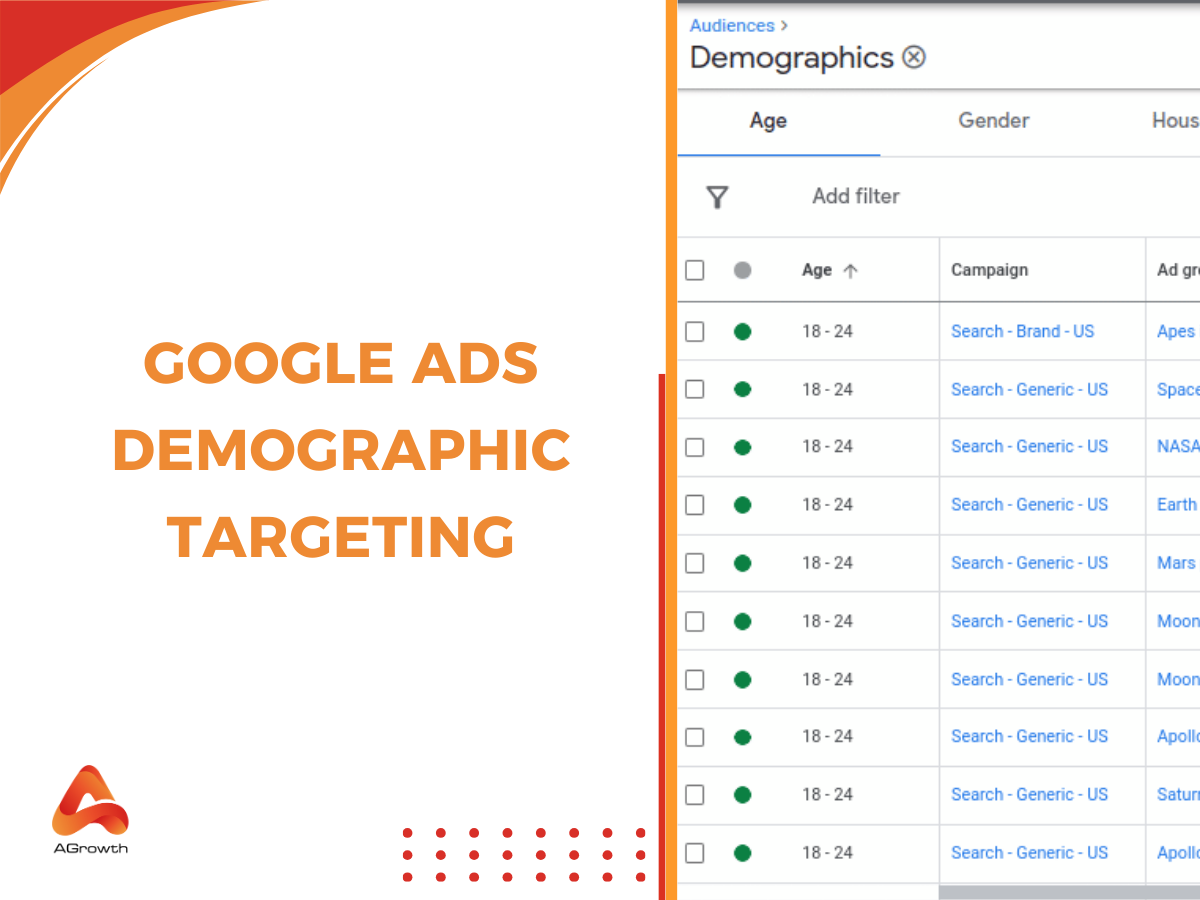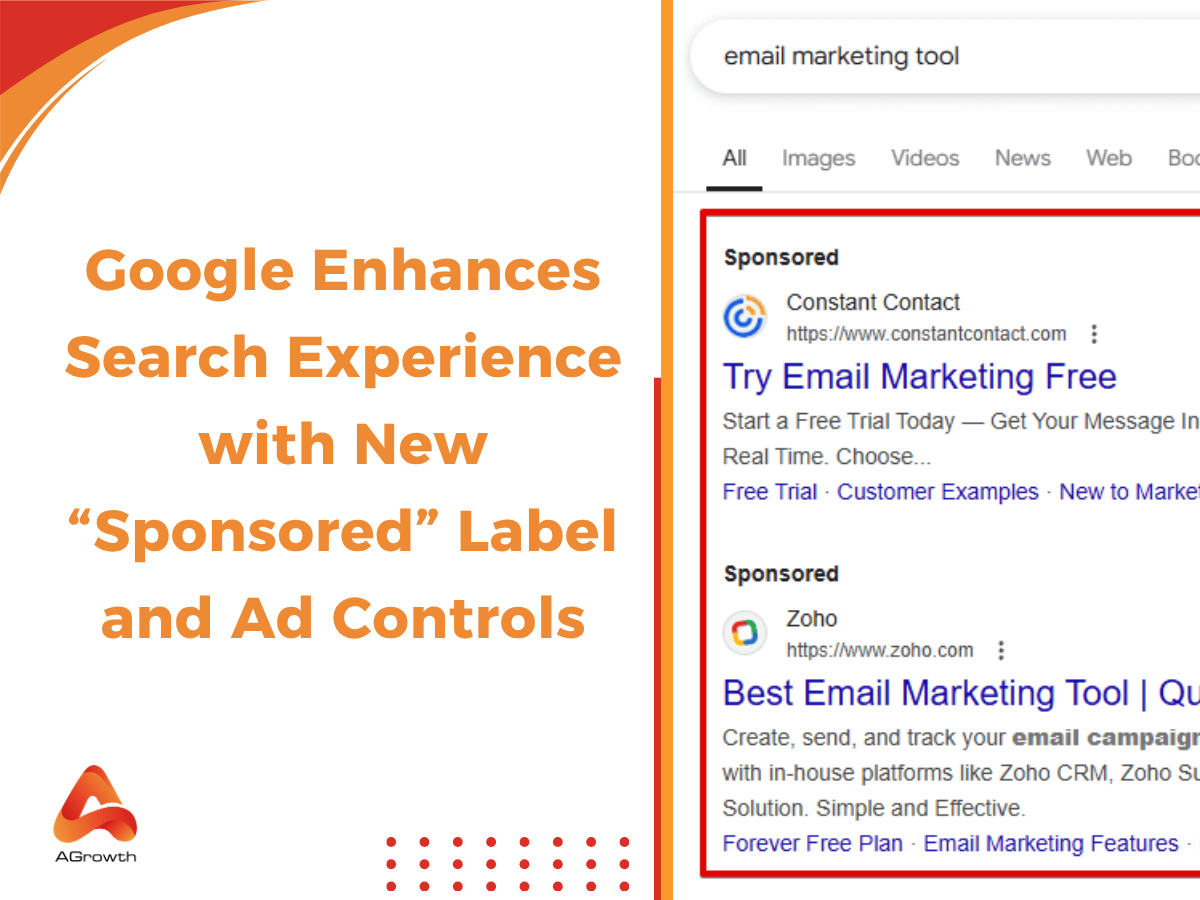
Table of Contents
Google Ads Demographic Targeting: A Complete Guide for PPC Professionals
Today, audience signals and demographic layers are as important as search terms in shaping campaign performance. Demographic targeting allows advertisers to refine their reach based on who users are — their age, gender, parental status, household income, or even life stage details like education and marital status.
For marketers in competitive markets such as the US and UK, mastering demographic targeting is no longer optional. It’s a lever that helps maximize ROI, reduce wasted spend, and align ads with the people most likely to convert.
In this guide, we’ll cover definitions from Google, break down the available categories, explore advanced tactics, and show how to combine demographics with other targeting methods for more powerful results.
What Is Demographic Targeting in Google Ads?
Demographic targeting refers to selecting or excluding ad audiences based on shared characteristics such as age, gender, or household income. According to Google Support, “Demographics are groups of people that share similar attributes. With demographic targeting, you can reach people based on factors like their age range, gender, parental status, or household income.”
This differs from keyword targeting, which is intent-driven, and from audience segments, which are behavior-driven. Demographic data provides advertisers with another dimension to filter or adjust their campaigns, enabling a more comprehensive strategy.
What is the difference between Demographics and Detailed demographics in Google Ads?
Google Ads separates demographic data into two layers: basic demographics and detailed demographics. Understanding how they differ is crucial for advertisers seeking to maximize targeting precision.
Basic Demographics
These are the core attributes that most advertisers are familiar with:
-
Age (18–24, 25–34, 35–44, etc.)
-
Gender (Male, Female, Unknown)
-
Parental status (Parent, Not a parent, Unknown)
-
Household income (Top 10%, 11–20%, 21–30%, etc. – available in select countries like the US and UK)
They represent broad characteristics and are useful for shaping high-level audience segmentation.
Detailed Demographics
This layer goes further by capturing lifestyle, education, and socioeconomic signals, such as:
-
Education level (High school, College, Graduate)
-
Marital status (Single, Married, In a relationship)
-
Homeownership (Renter vs. Homeowner)
-
Employment-related attributes (industry or company size, where available)
Key Difference
The distinction lies in scope and precision:
-
Basic demographics cover universal identity markers that are generally available across all campaigns.
-
Detailed demographics provide lifestyle and socioeconomic insights that allow advertisers to tailor messaging more granularly—for example, differentiating between a college student and a graduate professional within the same 18–24 age range.
This means a campaign could target “25–34 year-old parents” as a basic layer, and then refine further with “college graduates” or “homeowners” as detailed demographic signals.
If you’re exploring audience expansion beyond demographics, it’s worth learning how Google Ads lookalike audience segments can complement this approach for scaled prospecting.
Age Targeting Options in Google Ads
Age is one of the most straightforward demographic signals in Google Ads, yet it carries significant weight in shaping campaign efficiency.
The available age targeting segments in Google Ads are:
-
18-24
-
25-34
-
35-44
-
45-54
-
55-64
-
65+
-
Unknown

According to Google Support, “Not all users can be classified based on demographics, which means a portion of traffic may fall into the ‘Unknown’ category.” Excluding them entirely could result in missed reach, especially on mobile devices where demographic data may be limited.
Gender Targeting Options in Google Ads
Gender targeting gives advertisers the ability to align campaigns with the behavioral and preference differences between male, female, and unknown users. Categories are simple: Male, Female, and Unknown.
While on the surface this seems basic, gender often drives consumer intent in subtle but impactful ways. For instance:
-
Retail & fashion: men’s vs. women’s collections.
-
Healthcare: campaigns for maternity products versus men’s health supplements.
-
Financial services: messaging that speaks to gender-specific investment trends.
The “Unknown” segment remains important, as Google cannot always classify users. Rather than excluding, seasoned advertisers test creatives across all groups to ensure they are not unintentionally narrowing reach.

If you are already experimenting with audience segmentation, you may want to dive deeper into Google Ads audience targeting to see how demographic data layers with in-market and affinity signals.
Parental Status Targeting Options in Google Ads
Parental status offers a powerful lever for advertisers in industries such as retail, education, and consumer goods. Google Ads lets you distinguish between “Parent” and “Not a parent” categories, alongside “Unknown.”
This is especially valuable for:
-
Education providers targeting parents researching colleges or tutoring.
-
Retailers are running seasonal campaigns like back-to-school.
-
Entertainment & travel brands crafting family-focused offers.
According to Google’s official documentation, parental status data is derived from “users’ activity across Google properties that suggests their likelihood of being a parent.” This probabilistic approach means accuracy is high but not absolute—another reason to monitor performance reports closely.
Integrating parental targeting with remarketing can be particularly effective. Imagine layering “Parents” with Google Ads remarketing lists of recent site visitors—you’re now reaching high-intent, family-focused consumers.

Household Income Targeting Options in Google Ads
Household income targeting is where demographic segmentation intersects most clearly with purchasing power. Available primarily in markets such as the United States, United Kingdom, Australia, and select regions, this option divides users into Top 10%, 11–20%, 21–30%, 31–40%, lower 50%, and Unknown.
In the U.S. and UK, these income brackets are based on geographic and census data rather than individual disclosures. This makes it particularly effective for industries where spending ability matters:
-
Luxury goods: focus on top 10–20%.
-
Financial services: segment premium wealth products for upper brackets, everyday banking for mid-range.
-
Housing & real estate: align listings with income tiers likely to afford them.
Advertisers must avoid assumptions; higher income doesn’t always mean higher conversion. In some verticals, middle-income segments may actually produce stronger ROI because of larger audience volume.
Always review performance reports to test assumptions. Google provides breakdowns in the demographics tab, which can be combined with location targeting for even more precise campaign alignment.
For online retailers, aligning income tiers with product price points is crucial. Dive deeper into optimizing your product campaigns with our specialized guide on Google Ads for e-commerce.
How To Set Up Demographic Targeting
Setting up demographic targeting in Google Ads is a straightforward process. It can be done at either the campaign or ad group level. Setting it at the ad group level allows for more granular control.
-
Navigate to your Campaign or Ad Group: From the left-hand navigation menu in your Google Ads account, select the campaign or ad group you wish to modify.
-
Select 'Audiences, keywords, and content': In the secondary menu, find and click on this section.
-
Go to 'Audiences': This will open your audience manager dashboard.
-
Click 'Edit Demographics': You will see a button or link that allows you to edit the demographic targeting for your selected ad group or campaign.
-
Choose Your Targeting: A table will appear showing all available demographic groups (Age, Gender, HHI, Parental Status). You can select specific groups to target.
-
Set Exclusions or Bid Adjustments: For each demographic group, you can choose to "Target" them, "Exclude" them, or leave them as "Observation" (the default). In the "Bid adj." column, you can enter a percentage to increase or decrease your bid for that specific segment.
AGROWTH - GOOGLE AGENCY ACCOUNT
⭐ Managed campaigns with expert guidance
⭐ Flexible invoice-based billings, custom top-ups
⭐ High resistance to suspension via agency tier
⭐ Quick fund transfer to new account if needed
⭐ Priority support via Google Partner channel
⭐ Lower fees from 3-5%
⭐ Eligible for bonus credit up to $384
Best Practices for Using Demographics in PPC
Demographics are a signal, a strong one, but still a signal among many. Treat them as hypothesis-generating filters rather than binary rules. Below are field-tested, tactical best practices to get reliable, repeatable improvements from demographic targeting.
Start broad, then narrow with evidence
Begin campaigns with all demographic buckets enabled (the default). Collect conversion and audience-quality signals before excluding or narrowing.
Use the demographics report to find a statistically meaningful delta in CPA/ROAS before acting; don’t overreact to a small sample. Search Engine Land explicitly warns against premature exclusions.
Prefer bid adjustments and bid modifiers over hard exclusions
Use bid multipliers (or Target CPA/ROAS signals with Smart Bidding) to tilt spend toward higher-value groups rather than excluding. Bid adjustments preserve delivery and let automated bidding combine demographic signals with intent signals. Smart Bidding already ingests demographic signals as part of its decision-making.
While carefully managing audience exclusions is vital, refining your targeting with a strong list of Google Ad negative keywords is equally critical to prevent wasted spend.
Treat the “Unknown” bucket with care
“Unknown” can represent a large share of traffic (signed-out users, devices with limited signal). Excluding it can sharply reduce scale and increase CPA volatility. Analyze conversions coming from “Unknown” before deciding to exclude.
Match creatives, offers and landing pages to the demographic
Test messaging variants that reflect different life stages or income expectations (e.g., “family plan” vs “solo starter plan”). Use ad variations and responsive assets so Google can surface the best creative to each group. Creative alignment reduces friction and improves conversion rates.
Use reporting slices & custom columns for actionability
Build custom columns that show ROAS/CPA per demo group, and set saved reports/dashboards for weekly surveillance. Segment by device, geography, and time of day to catch cross-cutting effects (e.g., a high-income demo that converts only on desktop).
Drive decisions with statistical significance, not gut
Define thresholds for minimum conversions and confidence (e.g., min conversions per cell) before making bid or exclusion changes. If a demographic cell lacks data, prioritize data collection (wider targeting, higher bids) over irreversible exclusions.
Respect policy & special-ad-category constraints
If you’re in housing, employment, or credit verticals (or other sensitive categories), demographic targeting and exclusions are restricted — you must enable all demographic buckets in many cases. Always validate campaign classification against Google’s personalized advertising rules.
Instrumentation: link GA4 & use conversion modeling
Pass first-party conversion signals (server-side side where possible), link GA4, and use modeled conversions to reduce noise in small demographic cells. This improves the reliability of reports used to inform demographic optimization decisions.

Advanced Strategies for Demographic Targeting
These are higher-leverage tactics for teams that already follow best practices and want to squeeze additional ROI from demographic signals. They assume you have solid conversion data and the ability to iterate campaigns (creative, audience signals, bidding).
Audience choreography across funnel stages
- Awareness: keep demographics broad so ML can find scale and signals. Use demographic layers only in creative testing or to inform audience signals
- Consideration: apply mild bid boosts (+10–20%) to demographic groups that show above-average CTR or engagement
- Conversion/Retention: create narrow remarketing pools split by demographic + behavior (e.g., users who viewed premium product pages + household income = Top 20%). Use aggressive bids and bespoke creatives per pool.
This cross-campaign choreography lets you exclude or segment differently by campaign objective, avoiding over-restriction in upper-funnel activity. Search Engine Land and practitioners recommend against blanket exclusions across all campaign types.
Combined segments and Performance Max audience signals
Use Combined segments/audience signals (Performance Max & Demand Gen) where you feed together detailed demographics, in-market audiences and first-party lists. That creates richer signals for Google’s automation to find lookalikes and contextual opportunities.
Search Engine Land confirms that Detailed Demographics can be used as audience signals and combined segments.
Income-tier playbooks (not a one-size-fits-all)
For premium products: test a two-tier creative path — aspirational creative + premium offer to Top 10–20%; value-oriented creative to mid tiers. But measure CPA vs. AOV: sometimes mid-tier audiences convert at higher absolute volumes and better blended ROAS.
Search Engine Land explicitly cautions that household income targeting is inferred and limited — don’t assume the Top 10% equals the whole market for your premium buyers.
Dynamic creative and asset-level experimentation by demo
Use responsive search/display ads, multiple headlines, and experiment with different value props targeted to different demographics.
Let automated creative optimization find the best pairings per demo cell. Monitor asset-level performance and swap underperforming messaging quickly.
Cross-device & geo + demographic layering
Combine demographic targeting with geo micro-segmentation (e.g., affluent postal areas + Top 10% income bucket) to approximate income signals without over-reliance on a single data dimension. This can improve precision for local businesses and high-value services.
Cohort LTV modeling, then bid to predicted LTV
If you can model LTV by demographic cohort (via CRM + GA4), feed that insight into bidding logic — bid more for cohorts with higher expected LTV even if short-term CPA is higher. This turns demographic targeting into a long-term margin lever rather than a short-term CPA game.
Use exclusion tactically across campaigns (audience sculpting)
Instead of global exclusions, use strategic negative-demographic rules: exclude certain demos from awareness but include them in retargeting or email nurture flows. This audience sculpting preserves reach where ML needs it and tightens delivery where human judgment is needed.
Automated monitoring & scripts
Build automated alerts or scripts for demographic cells where CPA deviates by X% from baseline or impression share collapses, surface these anomalies for rapid human review. Combine with custom columns so alerts are business-relevant (e.g., CPA per LTV cohort).
FAQs
1. What is demographic targeting in Google Ads?
Demographic targeting in Google Ads allows advertisers to reach users based on attributes such as age, gender, household income, parental status, education, or marital status. It helps refine campaigns beyond keyword intent.
2. What is the difference between demographics and detailed demographics in Google Ads?
Basic demographics include age, gender, parental status, and household income. Detailed demographics expand further into lifestyle traits like education, homeownership, and marital status.
3. Can I exclude demographic groups in Google Ads campaigns?
Yes. Advertisers can exclude or adjust bids for certain demographic groups, but Google advises caution since exclusions may limit reach, and the “Unknown” group can represent a significant portion of traffic.
4. How accurate is household income targeting in Google Ads?
Household income data is modeled from aggregated signals and is only available in select markets such as the US and UK. It should be treated as directional rather than precise.
5. Why is the ‘Unknown’ demographic group important in Google Ads?
The “Unknown” group often includes signed-out users or those with limited signals. Excluding it can reduce reach significantly and harm campaign performance.
Related posts:









Your comment